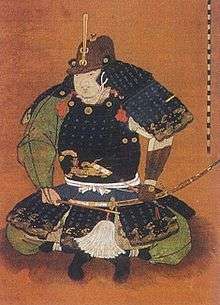Sakakibara Yasumasa
Sakakibara Yasumasa (榊原 康政, 1548 – June 19, 1606) was a Japanese daimyō of the late Sengoku period through early Edo period, who served the Tokugawa clan. As one of the Tokugawa family's foremost military commanders, he was considered one of its "Four Guardian Kings" (shitennō 四天王). His court title was Shikibu-Shō (式部大輔).[1]
Sakakibara Yasumasa 榊原 康政 | |
|---|---|
 | |
| Lord of Tatebayashi | |
| In office 1590–1606 | |
| Preceded by | none |
| Succeeded by | Sakakibara Yasukatsu |
| Personal details | |
| Born | 1548 Mikawa Province, Japan |
| Died | June 19, 1606 Edo, Japan |
| Nationality | Japanese |
| Military service | |
| Allegiance | |
| Commands | Tatebayashi Domain |
| Battles/wars | Battle of Batogahara Battle of Anegawa Battle of Mikatagahara Battle of Nagashino Battle of Komaki and Nagakute Battle of Sekigahara |
Early life
Sakakibara Yasumasa was born in the year Tenmon-17 (1548), the second son of Sakakibara Nagamasa, in the Ueno district of Mikawa Province. The Sakakibara were hereditary retainers of the Matsudaira (later Tokugawa) clan, classified as fudai. However, they did not serve the clan directly, but instead served one of its senior retainers, which at that time was Sakai Tadanao (which classified the Sakakibara as baishin, or "rear vassals"). The young Yasumasa interacted with Matsudaira Motoyasu (later Tokugawa Ieyasu) often from a young age, and was soon appointed his page. Due to his valor in the suppression of the Ikkō-ikki uprising in Mikawa, he was allowed to use the "yasu" from Ieyasu's name.
At this time, he unseated his brother and became head of the Sakakibara clan. There are two explanations for this. One is that his brother had been an ally of the Ikko Ikki rebels, and the other is that his brother was a retainer of Ieyasu's son Matsudaira Nobuyasu, who was implicated in what was most probably a non-existent treason plot against Oda Nobunaga.
Service under Ieyasu

In Eiroku-9 (1566), at age 19, Yasumasa had his coming-of-age ritual, and soon after, he and Honda Tadakatsu were made hatamoto by Ieyasu, and each granted command of 50 cavalrymen. From that point on, they would function as Ieyasu's hatamoto unit commanders.
Yasumasa battled at Anegawa in 1570,[2] Mikatagahara in 1573, along with the Nagashino in 1575. When Ieyasu chose to defy Toyotomi Hideyoshi, Yasumasa still served under Ieyasu, suggesting the region of Komaki would be suitable for the ensuing campaign. Yasumasa was given the title of "'Shikibu-Shō'", when accompanying Ieyasu to Osaka to meet with Hideyoshi. After the Tokugawa moved to the Kantō region, he was to have a team responsible for the allocation of fiefs. While Ieyasu was serving as one of Hideyoshi's staff in Kyūshū, Yasumasa was to supervise Kantō, as one of the chief administrators.
Later life
Yasumasa received the 100,000 koku fief of Tatebayashi han following the Tokugawa victory at the Battle of Sekigahara, which remained in the family for a few generations. Yasumasa himself died in 1606, at the age of 59, and is buried at Zendoji Temple in Tatebayashi, where his grave still stands.
| Preceded by none |
Daimyō of Tatebayashi 1590–1606 |
Succeeded by Sakakibara Yasukatsu |
See also
Notes
- Nussbaum, Louis Frédéric et al. (2005). "Sakakibara Yasumasa" in Japan encyclopedia, p. 811., p. 811, at Google Books; n.b., Louis-Frédéric is pseudonym of Louis-Frédéric Nussbaum, see Deutsche Nationalbibliothek Authority File Archived 2012-05-24 at Archive.today.
- Turnbull, Stephen (1987). Battles of the Samurai. Arms and Armour Press. p. 62. ISBN 0853688265.
References
- Nussbaum, Louis Frédéric and Käthe Roth. (2005). Japan Encyclopedia. Cambridge: Harvard University Press. ISBN 978-0-674-01753-5; OCLC 48943301
Further reading
- Bolitho, Harold. (1974). Treasures Among Men: The Fudai Daimyo in Tokugawa Japan. New Haven: Yale University Press. ISBN 978-0-300-01655-0; OCLC 185685588